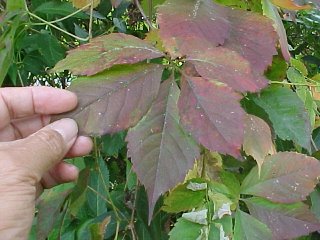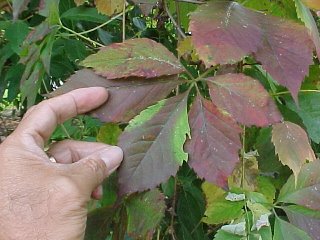

My program today was at the Woodstock Day School in Saugerties, NY. It was a complimentary program donated to the New York State Outdoor Education Association and auctioned off at their 2005 conference. A parent of a student at the school was the winning bidder and my day was set. We started of with nature songs and stories, operated a recycled paper factory, explored mammalogy and ended with a nature walk focused on trees.
We had a chance to look at leaf color change and discuss what was going on. This cool example of how sunlight reacts with the chlorophyll can be found in our school yards right now - especially with ash trees and Virginia creeper (pictured here). Color change happens when the leaf stems shut down - nothing can get in, nothing can get out. The leaves can’t make chlorophyll, which gets used up making sugar. The sugar that’s made is trapped in the leaf. As the chlorophyll is used up other pigments that have been in the leaf all summer long but masked by the chlorophyll start to show through - carotenes and xanthophylls producing orange and yellow. The sugars react with the anthocyanin pigments and result is deep reds and purples.
What you want to look for is leave that overlay one another - this often shows up nicely with white ash trees or Virginia creeper vines. Move the leaves aside and you will find a green “shadow”. The green is from the chlorophyll that is still in the leaves since the sun was shaded by the overlap. Where the sun shone on the leaf the chlorophyll was used up to make sugar and reacts with the anthocyanin to show up reddish-purple.
A great book to get on leaf color changes is Autumn Leave: A Guide to the Fall Colors of the Northwoods by Ronald M. Lanner, published by Northwoods Press, Inc.
No comments:
Post a Comment